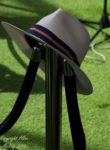 There’s no other way of saying this; 2020 has been an awful year and it’s been hard to take any kind of consolation from it. Anyone in the world of music has had to look long and hard to take any positives out of this situation. For many of us, it’s been an opportunity (or maybe a necessity) to look in the rear-view at some of the things we did in the past; gigs that we went to, albums that we bought and people that we met. I’ve moved around the country a fair amount and, in the era before media players and streaming, I had to limit the music I could move around with me. I’m not saying I was limited to five albums or, later, CDs, but these are albums that always made the cut and they’ve still had the same comfort blanket value through two lockdowns. In chronological order:
There’s no other way of saying this; 2020 has been an awful year and it’s been hard to take any kind of consolation from it. Anyone in the world of music has had to look long and hard to take any positives out of this situation. For many of us, it’s been an opportunity (or maybe a necessity) to look in the rear-view at some of the things we did in the past; gigs that we went to, albums that we bought and people that we met. I’ve moved around the country a fair amount and, in the era before media players and streaming, I had to limit the music I could move around with me. I’m not saying I was limited to five albums or, later, CDs, but these are albums that always made the cut and they’ve still had the same comfort blanket value through two lockdowns. In chronological order:
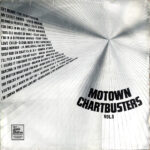 “Motown Chartbusters Vol. 3” – Various Artists
“Motown Chartbusters Vol. 3” – Various Artists
I know; it’s a compilation, but what a compilation. This was the soundtrack of my teenage years; every youth club disco, every party, every time I went to a friend’s house, this album was there. It was perfect timing, with a 1969 release just at the time that I really started to listen to music properly and had a few quid from my paper round to actually buy records.
The Chartbusters series started in 1967; if you’re a cynic, you might accuse Motown of trying to recycle material but it is the music business and it’s fair to say that this series was packed with hits. It was basically a singles industry at that time, so a compilation from a successful company made a lot of sense. So why Vol. 3? Well, the sleeve design evolved as the series progressed, reflecting current social themes, but Vol. 3 was the one where the designers nailed it; it’s simple, bold and incredibly striking and the musical content lived up to the standard of the design.
If a sixteen-song album starts with Marvin Gaye’s “Grapevine” and ends with Smokey’s “Tracks of my Tears”, there’s a lot of wiggle room for the other fourteen songs. Throw in a couple of Stevie Wonder classics, The Temptations’ “Get Ready” and Edwin Starr’s “Stop Her on Sight” and you’ve already got a classic compilation. Take a look at the entire album and it’s studded with classics and minor classics. That’s why it will always have a place in my elite albums.
I bought this the week it was released in September 1977 and took it with me to Dundee for my second year at University. I was in a shared room, but it was with Kev, my room-mate from my first year. We both played guitar and had some musical tastes in common; thankfully Steely Dan was one of those shared tastes. “Aja” was played a lot and we may have smoked some recreational substances, which may have enhanced the listening experience. In my final two years, I had my own room and, again, “Aja” didn’t stay in its sleeve very long. It was starting to look a little worse for wear. You can read the next part of this story in this piece; I don’t want to do it in detail again here. Let’s just say it burned “Aja” into my consciousness and since that time the album’s been a constant companion.
I’d been a Dan fan since the early days and, by this time, I knew to expect the unexpected but this album was something else. They had seven beautifully-constructed and slightly sleazy songs (ok, maybe more than slightly sleazy) and spent studio time with the best session musicians in the world putting together versions of the songs, picking out the seven favourites for the album. They started as jazzers playing rock and with “Aja” they arrived at jazzers playing jazz or maybe jazz-funk; going back to their roots. Like all of the albums mentioned here, this should be in everyone’s collection. It was certainly in the collection of the next band.
I’m Scottish; I’m proud to be a Scot and I used to love the times when the music industry radar periodically located Scotland on the UK map. The mid-to-late eighties was one of those periods; Deacon Blue were one of the bands to be signed and they’re still recording and gigging today. I saw them at Cornbury a couple of years ago and they sounded great with songs covering a period of thirty years. The band members mostly have new day jobs now; Ricky Ross is a radio broadcaster and Dougie Vipond is a TV presenter with BBC Scotland, but that’s all irrelevant when the sticks click and the band fires up.
I bought “Raintown” on vinyl originally and I still have that copy now. The title song was a tribute to Glasgow that spliced Blue Nile with Springsteen to create a wide canvas sound that came to define the band. As much as I loved that song, and the anthem “Dignity”, it was “When Will You (Make my Telephone Ring?)” that I connected with. It was a soul song (they even had Jimmy Helms on BVs) and it was over the top and gorgeous. It was part of an album that you needed to listen to from start to finish (turning over the vinyl halfway through), because you wouldn’t want to miss out on the opener “Born In a Storm” or the yuppie tale “Chocolate Girl”.
And you know that the Steely Dan connection is “Deacon Blues” from “Aja”, obviously.
When the Britpop wars broke out, I was missing in action. Why would anyone hitch themselves to bands that were so obviously influenced by sixties pop. Oasis was The Beatles without the subtlety and Blur was an arch Goldsmiths-enabled Kinks tribute band. We had to be better than that and I’d already committed myself to a band that had much more in common with the East Midlands surroundings I knew as a teenager. The band was from Sheffield and the songs reflected life in the North Nottinghamshire/Derbyshire/South Yorkshire area; Blur and Oasis were copying sixties bands while Pulp felt much more like a musical interpretation of Stan Barstow’s short stories.
“His ‘n’ Hers” was the breakthrough album: it wasn’t the album with the anthems that followed it and turned Pulp into an arena and Glastonbury-headlining band. “Different Class” featured “Common People” and “Disco 2000”, both complete bangers and remixed to within an inch of their lives; as much as I loved them, I still identified much more with the characters and the narratives of “Lipgloss”, “Babies”, ”Acrylic Afternoons” and “Do You Remember the First Time?”. This is still my favourite Pulp album and probably my favourite ‘Britpop’ album.
Only a few months after “His ‘n’ Hers” and so different. If Sheffield defined Pulp, then Bristol defined Massive Attack. The first Massive Attack album “Blue Lines” three years earlier was already firmly embedded in my consciousness. “Unfinished Sympathy” was a classic single and Shara Nelson had a perfect voice to front up the songs. Massive Attack wasn’t a prolific band (quality rather than quantity) and by the time “Protection” came along, Shara had moved on, replaced by a mix of singers and rappers including Tracey Thorn, Tricky, Nicolette and Horace Andy. Along with close neighbours Portishead, Massive Attack defined trip-hop, mixing influences from hip-hop and dub, creating a sound that was both ambient and punchy.
The title song has always pushed my buttons; it’s gorgeous. The bass is thunderous (particularly for a slow ballad), while the guitar, keys and vocals are all crystal clear with a shimmering touch of reverb. The mix is full of space and all of the individual elements stand out. And there’s Tracey Thorn’s almost effortless but incredibly powerful vocal. It’s a classic song and it sets the tone for the album; loads of punchy bass and spacy, dubby mixes – trippy even. The kind of music that might accompany a spliff or two. Which takes us back to my second selection.
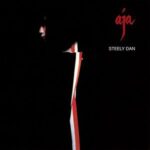 Some albums in your collection, however important they are musically, take on an importance in your life that goes way beyond some sounds coming out of boxes in the corner. Sometimes an album worms its way through your defences to connect up with all sorts of other parts of life and, before you know it, the songs have become inextricably entangled with memories of friends, family and lovers; and there’s no way of untying those knots. “Aja” is one of those albums for me; it has mellow memories of my student years, memories of friends met along the way and tragic memories of one of those friends taken when she had everything before her.
Some albums in your collection, however important they are musically, take on an importance in your life that goes way beyond some sounds coming out of boxes in the corner. Sometimes an album worms its way through your defences to connect up with all sorts of other parts of life and, before you know it, the songs have become inextricably entangled with memories of friends, family and lovers; and there’s no way of untying those knots. “Aja” is one of those albums for me; it has mellow memories of my student years, memories of friends met along the way and tragic memories of one of those friends taken when she had everything before her.
“Aja” was released in October 1977 and the timing was perfect for me. It was the start of my second year at Uni and I’d escaped from halls into a flat where I shared a room with a mate from my first year. We were both musicheads, both played guitar after a fashion and I had a reasonably good stereo. It’s fair to say there was music playing from the moment one of us woke up until the last head (usually mine) hit the pillow. I had a well-paid summer job (which I could tell you a few stories about), so I hit Dundee every October with plenty of readies to support the local record shops.
I was already a bit of a Steely Dan fan, so “Aja” was a no-brainer for me. As I listened to it end-to-end for the first time, I read the lyrics, the list of musicians involved on each track (which I now realise was a guide to the best session guys in the world at that time) and the sleeve notes written by Michael Phalen after spending some fraught and unprofitable time with Becker and Fagen trying to extract some sensible contributions. Typical of their contributions was the description of “Peg” as a ‘pantonal thirteen blues with chorus’; luckily Michael wasn’t a guy to bear a grudge.
It was a strange time for a band like Steely Dan; they were the antithesis of the punk philosophy. I loved the energy of punk/new wave/power pop but I wasn’t willing to take the slash and burn attitude to older music (it cost me a fortune to buy this stuff, no bloody way was I just ditching it). The album took an age to make, the playing was exquisite and there were only seven tracks, none of them less than four minutes long. Just compare that to a Ramones album with fourteen songs, none much more than two minutes long (and I loved The Ramones as well), but “Aja” was about pure musical class, cryptic and coded lyrics with a seedy undertone and some outrageously good solo playing. I didn’t realise at the time that I’d bought a jazz album.
And talking of jazz, that was exactly the kind of cigarettes that accompanied listening to “Aja” for my university years; it was the perfect match, mostly laid-back arrangements, lots of space and perfect to chill out to. It was one of half a dozen albums that always found their way to the deck over the next three years, however many new albums I bought. I wasn’t even choosy about picking favourites; there are seven tracks, “Black Cow”, “Aja”, “Deacon Blues”, “Peg”, “Home at Last”, “I Got the News” and “Josie” and they’re all stunningly good. I would happily listen to any of those songs at any time. But the university idyll couldn’t last forever and I settled back in with my family for a while after graduation. It was the beginning of the Thatcher era and I was living in Mansfield; it was obviously going to be grim, or so I thought.
I settled into a temporary job and listened to a lot of depressing post-punk until something very strange happened. On the regular Friday night out, a mate suggested a visit to The Red Lion, a fun pub (think sleazy, cheesy and very camp) that had just taken off. I was hooked, and after the second visit I landed a weekend bar job there. If the memoirs ever come together, there’s a chapter there that might need very careful legal scrutiny. And that’s where I met Gill (beautiful with a razor-sharp wit) and her friend Denise, both nurses doing part-time bar work. Within a few weeks, we’d all decided to share a house together on Woodhouse Road with another friend, Andy, and I was living a student life again.
I brought one important thing to the party; my record collection. Within a few days, Gill had discovered “Aja” and I realised I would never really own the album again. As much as I loved you Gill, I have to say you absolutely trashed that album; fingerprints all over the first track on each side, and the album never, ever went back in its sleeve. Did it matter? No it didn’t, because she loved the album with such a passion I couldn’t get angry about it. It wasn’t unusual to walk in and find Gill in her underwear ironing that night’s outfit while listening to “Aja” (we always popped a head round the living room door before inviting guests in). We were great mates anyway, but this album was something that created an everlasting bond. While we shared that house, we both formed the relationships that defined our lives (and a few that didn’t); and “Aja” was always there in the background.
Life moved on, the way it does in your early twenties when you think you’ll live forever, and we all left the house to move in with our various partners but kept in touch, directly or on the grapevine as we moved in our chosen directions. Gill started a successful business, fell in love with a nice guy and they had three beautiful daughters. I drifted through nightclub and pub management, the dole queue and self-employment and finally, in 1992, landed a job in entertainments for the armed forces. It was great news and I was all ready to make a new start on a residential training course. Everything was good; and then the doorbell rang.
Denise was on the doorstep, in tears. Gill wasn’t with us any more; she’d had a massive brain haemorrhage a few days before while out shopping and her life support had just been switched off. It wasn’t the first time I’d had to deal with a sudden death (from the other side of the doorstep), but this was someone I’d lived with, and loved, and I thought would always be a part of my life. She had a loving husband and three daughters under five and she had gone, forever. Because of the new job two hundred miles away, I couldn’t get to the funeral (an older me would say ‘Fuck the new job’), so I had to be represented. I still miss Gill to this day; she was the kind of person that took up a huge space in your life and there was a huge hole when she left.
And what was left? Well, I still love “Aja”, and every time I listen to the album, particularly the vinyl version that still has all of the marks and noises left by Gill, I remember that beautiful person ironing in her bra and knickers and singing along to “Peg” at the top of her voice.
And there’s a postscript to this story. On October 30th 2017, I finally got to see Steely Dan live on a double bill with The Doobie Brothers at the 02. The band, as you would expect, was absolutely superb, but the atmosphere was slightly muted because of the death, less than two months before, of Walter Becker. A few gallons of silent tears were shed that night, but mine didn’t really have anything to do with mourning Walter Becker.
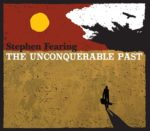 Stephen Fearing’s thirteenth solo album’s very personal and, at the same time it’s also political, but this isn’t just one for the social theorists because those elements are inextricably linked with the musical settings for the songs. Three of the songs on the album are named for people and there’s a strong vein of nostalgia running through the lyrical and musical stylings of “The Unconquerable Past”, although this isn’t by any means wallowing in the past; it’s much more of a realisation that there’s always a danger of dismissing older musical styles as no longer relevant in the headlong rush to be on-trend. It’s not a new thing, those wonderful old cynics Becker and Fagen nailed it in their own beautifully sleazy way in “Hey Nineteen” in 1980: ‘Hey, nineteen, that’s ‘Retha Franklin, she don’t remember the Queen of Soul’.
Stephen Fearing’s thirteenth solo album’s very personal and, at the same time it’s also political, but this isn’t just one for the social theorists because those elements are inextricably linked with the musical settings for the songs. Three of the songs on the album are named for people and there’s a strong vein of nostalgia running through the lyrical and musical stylings of “The Unconquerable Past”, although this isn’t by any means wallowing in the past; it’s much more of a realisation that there’s always a danger of dismissing older musical styles as no longer relevant in the headlong rush to be on-trend. It’s not a new thing, those wonderful old cynics Becker and Fagen nailed it in their own beautifully sleazy way in “Hey Nineteen” in 1980: ‘Hey, nineteen, that’s ‘Retha Franklin, she don’t remember the Queen of Soul’.
To come back to Stephen Fearing, this album is a bit of a departure from his solo material in that, at times, there’s a full rock band behind some uptempo tunes, one of which, “Christine”, goes way back to classic rockabilly styling and it’s a lot of fun. The other notably uptempo song, “Stay with Me” has its roots firmly in drivetime rock that Bob Seger seemed to knock out for fun in the late seventies.
If there’s one theme above all others pulling the album together it’s empathy, particularly where people with differences are dealing with harsh and unforgiving society we live in today. “Sunny” is a great example as the story is gradually revealed of a transgender individual leaving home to eventually find a relationship that works. The writer isn’t judging, and preaches the same tolerance in “Someone Else’s Shoes”; we should always try to understand the pressures someone else is facing rather than rushing to condemn.
Personal highlights are the poignant “Emigrant Song”, co-written with Andy White, dealing with the conflicting tensions of moving and looking back at happy memories, and the title song, with the message that we are products of our past but we don’t have to be defined by it. The album closes out with “No Country”, a solo acoustic ballad that positions the troubadour as a citizen of nowhere at all.
“The Unconquerable Past” is a collection of ten high-calibre songs performed with quality and taste that will make you tap your feet and make you stop and think. Not a bad combination.
“The Unconquerable Past” is out in the UK now in various physical and digital formats of Fish Records (FRCD03).
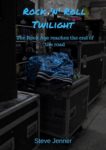 We don’t get too many chances to do book reviews, but I’m absolutely insisting on doing this one. “Rock ‘n’ Roll Twilight” is the work of our very own contributor, and friend for longer than either of us can remember, Steve Jenner. The central premise of the book is very simple; the golden age of rock ’n’ roll, for a variety of reasons, is over and we’re now witnessing what my friends who still live Up North would call its last knockings. I’m not going into that in detail, because I’m hoping you’re going to read it for yourself and find out.
We don’t get too many chances to do book reviews, but I’m absolutely insisting on doing this one. “Rock ‘n’ Roll Twilight” is the work of our very own contributor, and friend for longer than either of us can remember, Steve Jenner. The central premise of the book is very simple; the golden age of rock ’n’ roll, for a variety of reasons, is over and we’re now witnessing what my friends who still live Up North would call its last knockings. I’m not going into that in detail, because I’m hoping you’re going to read it for yourself and find out.
Besides the basic premise, what Steve has done is collected a series of reviews written during his lengthy odyssey to try to catch as many of the bands that we have loved over the years while we still have the opportunity. Sometimes the attempt to catch the bands has only been partially successful; in the period between buying tickets for Steely Dan and seeing the show, Walter Becker (one half of the partnership) died and the show had some of the feel of an upbeat memorial. The artists reviewed cover a diversity of musical styles and range from global megastars to not-even-a-hit-in-the-UK. It’s a perfect cross-section of the music that is only rock ‘n’ roll (but we like it). Some of the reviews have appeared here in the past; some haven’t and I’m hoping we’ll see more in the future.
Don’t get the idea that this is a favour for a mate. We only feature bands, gigs, albums, singles and even books on MusicRiot that we love and we want to share with the world. The other thing is that Steve can write; no argument on that at all. Here’s an example from the book and my favourite intro to a review:
‘My mate can drink 3 pints of lager through a straw in less time than it takes to boil a kettle.
According to some, this makes him a ‘legend’.
Brian Wilson is regarded by many as a ‘genius’.
I would argue these labels have caused problems for both men and have probably influenced their behaviour and probably not in a good way.’
Steve has also given credit to some unsung heroes; the actual venues hosting these events. The final section of the book is a series of short pieces about the places these bands were seen in, ranging from the Foxlowe Centre in Leek to the O2 in Greenwich and all shapes and sizes in between. Part fact/part personal opinion, it gives real feel for ambience of these buildings.
Writing’s a skill; you can learn, you can make yourself better. The unique qualities that make this a standout piece of work are Steve’s knowledge of his subject (trust me, most of this stuff is in his head) and his sheer enthusiasm for all aspects of music. Passion, knowledge and skilful writing combine to create a little gem that you won’t want to put down.
And I was almost too modest to mention that I took the cover shot; almost.
 There are a lot of things that go a long way to making a great record, in my humble, and a couple of them are great musicianship (controversial, but I include singing in that) and a sense of joy; this album has both of those in abundance. Track Dogs (the name’s taken from the denizens of the deeps of the New York subway) is Garrett Wall, Dave Mooney, Howard Brown and Robbie K Jones (two Irishmen, an Englishman and an American) who met up in Madrid. You might expect a mashing of influences, but “Kansas City Out Groove” goes way further than that. It fuses reggae, string band arrangements, Spaghetti Western and jazz and even hints of pop.
There are a lot of things that go a long way to making a great record, in my humble, and a couple of them are great musicianship (controversial, but I include singing in that) and a sense of joy; this album has both of those in abundance. Track Dogs (the name’s taken from the denizens of the deeps of the New York subway) is Garrett Wall, Dave Mooney, Howard Brown and Robbie K Jones (two Irishmen, an Englishman and an American) who met up in Madrid. You might expect a mashing of influences, but “Kansas City Out Groove” goes way further than that. It fuses reggae, string band arrangements, Spaghetti Western and jazz and even hints of pop.
There’s a rare combination of four great players who also have superb voices, creating stunning individual vocal performances and the almost inevitable perfect harmonies. So where do you even begin to start picking out favourites? The Latin trumpet and rhythms and the nailed-on harmonies of the opener, “The Deep End” set the scene nicely, the lead vocal having more than a suggestion of our great British blues and soul hero, Aynsley Lister, and the hundreds and thousands come with the trumpet solo doubling up to two horns as the song plays out.
And from there on in, anything can happen. My personal highlights are the midtempo “Find Me a Rose”, blending folk song themes of life coming from death with Latin rhythms and constant tempo changes. “I Don’t Want to Ruin It” combines clipped funk guitar parts, a powerful trumpet solo and hints of David Gray’s “Babylon” to question where a relationship should go next and “Born in Love” has a chorus that is pure Steely Dan circa “Can’t Buy a Thrill”. Last, and definitely not least, is “My Big Payday” packed with tempo changes, Chicago/Asbury Jukes horns, a classic swing feel and a whole bundle of fun.
The playing is outstanding, the harmonies are superb and it’s joyful throughout; just give it a listen.
“Kansas City Out Groove” is out now on Mondegreen Records.
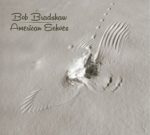 It’s a musical ‘all you can eat’ buffet; a long-time outsider’s view of American popular music exploring some of the high protein meat dishes, but meandering through some of the more delicately flavoured and textured dishes as well. To add to the complexity, it’s a set of songs created by a self-taught musician who also happens to have studied for a popular music degree. Sophistication and raw rock power are both on the menu for this musical feast. On his previous album, “Whatever You Wanted”, Bob Bradshaw saved the best (in my opinion) for last, closing the album with the wonderful road song, “The Long Ride Home”. On “American Echoes”, he opens with the lovely, acutely-observed “Exotic Dancers Wanted”; all of smalltown America is there as he melds Tom Waits with Bob Seger’s “Mainstreet” to create a quiet classic of a song about desperation, drugs, booze and pole-dancing. He even throws in a W.B. Yeats reference.
It’s a musical ‘all you can eat’ buffet; a long-time outsider’s view of American popular music exploring some of the high protein meat dishes, but meandering through some of the more delicately flavoured and textured dishes as well. To add to the complexity, it’s a set of songs created by a self-taught musician who also happens to have studied for a popular music degree. Sophistication and raw rock power are both on the menu for this musical feast. On his previous album, “Whatever You Wanted”, Bob Bradshaw saved the best (in my opinion) for last, closing the album with the wonderful road song, “The Long Ride Home”. On “American Echoes”, he opens with the lovely, acutely-observed “Exotic Dancers Wanted”; all of smalltown America is there as he melds Tom Waits with Bob Seger’s “Mainstreet” to create a quiet classic of a song about desperation, drugs, booze and pole-dancing. He even throws in a W.B. Yeats reference.
To keep the culinary metaphor on the boil, “American Echoes” is a smorgasbord of musical stylings, or a pick ‘n’ mix if prosaic is your preference. It ranges all the way from the out and out rocker “Weight of the World”, with its huge riff, two guitars and The Who stylings to the acoustic ballad “Stella” with a Chris Izaak guitar sound and a vocal that’s a dead ringer for Elvis Costello in lower-register ballad mode.
There’s a bit of lyrical invention as well, to match the musical melange. “My Double and I” is a modern take on the Jekyll and Hyde theme matched up with a laid-back New Orleans jazz groove (with a nod towards Steely Dan’s “East St Louis Toodle-oo”), while “Working on My Protest Song” combines the kind of rhythms Paul Simon discovered in Africa with a mildly sarcastic dig at musicians who opportunistically appropriate protest movements for their ends. And the list goes on.
The bottom line is that Bob Bradshaw has produced another very fine album indeed. “American Echoes” is packed with great lyrical and musical ideas and gets better with repeated plays.
“American Echoes” is released in the on UK Fluke Records on Friday October 20.
 The Korvids, eh? I’m guessing it’s a korruption of the scientific term for the crow family. Anyway it’s the name given to a project put together by James Grant (surely I don’t have to tell you about his history) and Gordie Goudie (Simple Minds producer and former member of Echo and the Bunnymen and The Primevals). So the obvious collaboration would be a disco album, right? Well, not strictly; it’s certainly a dance album, but there’s a lot more than just disco lurking in “The Korvids”. Is it so far away from the music they’ve made in the past? In James Grant’s case, I would probably say no; he’s always had a bit of a funky element to his guitar playing and he’s not afraid to experiment, so a dance album’s not such a big step. Now a cheerful dance album; that’s another thing entirely.
The Korvids, eh? I’m guessing it’s a korruption of the scientific term for the crow family. Anyway it’s the name given to a project put together by James Grant (surely I don’t have to tell you about his history) and Gordie Goudie (Simple Minds producer and former member of Echo and the Bunnymen and The Primevals). So the obvious collaboration would be a disco album, right? Well, not strictly; it’s certainly a dance album, but there’s a lot more than just disco lurking in “The Korvids”. Is it so far away from the music they’ve made in the past? In James Grant’s case, I would probably say no; he’s always had a bit of a funky element to his guitar playing and he’s not afraid to experiment, so a dance album’s not such a big step. Now a cheerful dance album; that’s another thing entirely.
The album covers a range of styles; the opener ”Bad Faith”, with its four-to-the-floor kick, congas, funky keys, hi-hats, melodic bassline and horns is pure joyous mid-seventies Studio 54. James Grant even throws in an Ernie Isley style guitar solo for good measure. Maybe a hint of the Average White Band in there as well. And that’s just the first song. “Tender Tyrannies” is about old records and the memories attached and has a Soul II Soul feel with a female vocal, squelching synth bass and clipped, funky guitar, “Slouch” has a groove that’s part Steely Dan, part humanistic Kraftwerk and previous single “Beach Coma” has an ambient Goa trance feel with synth pads and swirls and an acoustic guitar hook. Elsewhere, you can hear elements of Massive Attack and Eastern music in “Be My Enemy” and trip-hop in “Are You Bored with Me Baby?”
If you were a clubber in the late eighties/early nineties and you’ve grown up since then, this is the album for you. It feels a bit like the dance production process has been turned on its head; instead of building up from a groove and adding layers to create the finished product, this feels like the songs came first and the backing tracks were written to fit the songs. Either way, it’s a cracking album.
“The Korvids” is released on Friday April 28 on Nang Records.
And while we’ve got you here, how about checking a stunningly good song about Scottish families, another of James Grant’s classics:
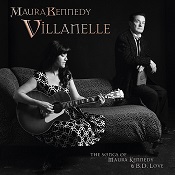 “Villanelle” is the second instalment of a trilogy of albums released by Pete and Maura Kennedy in 2015. It’s a Maura Kennedy solo album but, not surprisingly, Pete’s a presence throughout, playing electric guitar, banjo, mandolin, organ, glockenspiel bass and drums. The album is a collaboration with Californian poet B.D. Love which was hatched in the summer of 2014 as a creative challenge. B.D. Love provided Maura with a set of poems which she had to be turn into songs without changing their structure. Now, that may sound like an interesting academic exercise but the project has produced some of the most beautiful songs I’ve heard this year by fusing poetic forms with a range of musical settings from across the Americana spectrum.
“Villanelle” is the second instalment of a trilogy of albums released by Pete and Maura Kennedy in 2015. It’s a Maura Kennedy solo album but, not surprisingly, Pete’s a presence throughout, playing electric guitar, banjo, mandolin, organ, glockenspiel bass and drums. The album is a collaboration with Californian poet B.D. Love which was hatched in the summer of 2014 as a creative challenge. B.D. Love provided Maura with a set of poems which she had to be turn into songs without changing their structure. Now, that may sound like an interesting academic exercise but the project has produced some of the most beautiful songs I’ve heard this year by fusing poetic forms with a range of musical settings from across the Americana spectrum.
At fifteen songs long, I’m not even going to attempt to feature every song; there isn’t a bad, or even an average one, so I’m going with a few of my personal highlights, in no particular order. “She Worked her Magic on Me” is probably the most light-hearted of the lyrics; full of wordplay and double entendre, it’s a joyous romp of a song telling the tale of the amorous exploits of a magician’s assistant, featuring a nice gipsy jazz nylon-strung guitar solo from Pete. It’s not typical of the songs on the album, but it’s great fun. “Be the One” sounds like 1972 all over again with a groove that’s somewhere between Carly Simon’s “You’re so Vain” and Steely Dan’s “Do it Again” as a backdrop for a relatively straightforward love poem. As a bonus, Pete builds up the texture and atmosphere with some very moody organ.
“Borrowed Dress” is a very feminist piece showing the human cost of economic migration and ending with a prayer that the daughter of the central character will live a better life because of her mother’s sacrifice. It’s heart-rending stuff set against an appropriately Mexican-tinged arrangement. “Darling Cutter” isn’t just heart-rending, it’s harrowing; the back-story is established quickly before plunging into a cycle of alienation and self-harm which the narrator can see and is trying to break, although there is a hint at complicity. The contrast between the lyrical darkness and the uptempo, almost jaunty, feel of the song helps to emphasise the pathos of the events which unfold.
If you ever need an example of perfect track sequencing on an album, here it is; the song following “Darling Cutter” is the absolutely gorgeous “I Cried to Dream Again”, which is inspired by Caliban’s famous dream speech in “The Tempest”. The theme of the song is an unrequited love, but the musical setting and the achingly beautiful chorus feel like a resolution to the previous song’s darkness.
There’s no argument here about whether song lyrics are poetry or not (and that’s a discussion I’ve had a few times) because that’s how these lyrics started. Maura Kennedy has risen to an incredibly difficult technical challenge by crafting arrangements across a wide variety of styles which enhance the poetry and, as always, her lead and harmony vocals are perfect. When you add Pete Kennedy’s multi-instrumental skills to the mix, the result is an album that’s technically flawless and packed with feeling and emotion. You can’t ask for much more than that.
“Villanelle – The Songs of Maura Kennedy and B.D. Love” is out now on Varèse Sarabande (302 067 339 8).
You can read the interview I did with Pete and Maura in London earlier this month here.
 “Meanwhile” – Part Time Heroes
“Meanwhile” – Part Time Heroes
Whilst this is completely new to me and probably the best album I’ve heard in 2014, it actually got released back in 2008 but pretty much passed everyone by. I first heard the track “Shadowlands” on Jamie Cullum’s Jazz show that airs on Radio 2; my ears pricked up immediately and I instantly sought out the album, which is a gem, not a duff track on it. They use various vocalists and it certainly has a contemporary jazzy feel to it but I also hear echoes of Terry Callier and lots of other stuff going on. It’s destined to be one of those lost classics, certainly worth investigating for sure.
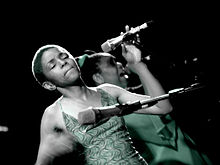 Carleen Anderson at Ronnie Scott’s
Carleen Anderson at Ronnie Scott’s
I didn’t get to as many gigs as I would have liked to this year due to Stone Foundation’s hectic schedule throughout 2014. The one that really stood out head & shoulders above everything else I saw this year was Carleen Anderson’s performance at Ronnie Scott’s at the start of the year. She is (still) such an underrated talent with an exceptional vocal range, obviously we (Stone foundation) were very fortunate to have Carleen grace our last album where she contributed an amazing vocal to one of our songs called “When You’re in My World“. She is an amazing songwriter and arranger too; her new material is just outstanding, as good as anything she has ever written and I really hope it sees the light of day sometime soon. It was an inspiring evening and one that will stay with me.
 “Eminent Hipsters” – Donald Fagen
“Eminent Hipsters” – Donald Fagen
I’ve been reading a lot this year, much more so than usual, I have no idea why, perhaps I have been looking for inspiration to kick start my own scribblings again; I’m 12 chapters in to my first book but kind of stalled once again really due to other commitments but I hope to pick up the trail again come the new year and get it finished. This book by Steely Dan main man Donald Fagen was a real treat, his words danced from the pages. It covers all the cool hipster characters that influenced his own inevitable style, it also covers his late college years in New York where he first met Walter Becker his co-founder and musical partner in Steely Dan. It’s a very funny book too, especially in the latter chapters when documenting his time on tour recently with Boz Scaggs & Michael Mcdonald. It brings to life the up’s and down of the anxieties and indignities of life on the road in the most brilliantly humorous way.
This year I rediscovered the joys of the radio. A couple of programmes in particular really inspired me. Ana Matronic’s Disco show that aired on Friday nights for six weeks on Radio 2 was a real winner; she didn’t so much play obvious disco musak in the sense of the naff, cliched sound you would imagine but focussed on the real grooves of that period such as the influential Salsoul sound and some of the orchestral arrangements that people like Barry White popularized with Love Unlimited and also the wonderful world of Gamble & Huff and that whole Philly thing. It introduced me to a lot of new stuff that I hadn’t heard previously like Francine McGee’s “Delirium”; I also ended up buying the whole works, a box set of Philly stuff. Don Letts’ show on 6 Music has also turned me on to a lot of new music too; only last night I heard something by Jaga Jazzist called “Made for Radio” that had my attention from the off. I think it’s great to know that there is still some really thoughtful radio still being aired and made; long may it continue. It’s how I first got inspired, by listening to Peel on a transistor in my bedroom when I should have been doing my homework; I guess in many ways I was………
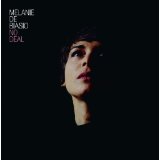 “Space is the Place” – Yusef Lateef / Melanie De Biasio “No Deal”
“Space is the Place” – Yusef Lateef / Melanie De Biasio “No Deal”
I’ve been gravitating towards a more jazzy sound over the past couple of years. I’ve kind of not lost interest but put Guitar / Rock music on the back burner for a while; it’s not what I want to inform me when it comes to my own writing at the moment. I’m more pre occupied with space in arrangements; this Yusef Lateef track kind of personifies that mind set. I’ve heard a lot of great new music too this year but mainly in a pop vein like the Jessie Ware album & that Jungle single “Busy Earnin'” which I really liked. Also one of my favourite new albums and discoveries of this year has been the Melanie De Biasio album “No Deal…”; she is a classically trained flautist from Belgium who has a tremendous voice too. It’s a great record and one that also exemplifies my love of space in the music. It’s not in a hurry to impress; it creeps up on you. In saying all of this I must admit that I was impressed with Ryan Adams’ spectacular return to form on his last (self-titled) LP; the production and sound of it is incredible. It sounds like “Rumours” which is a tough task to pull off.
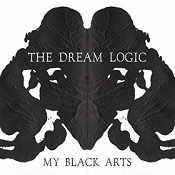 So, here’s an interesting one; “My Black Arts” is the second album from The Dream Logic. The core of the band is singer and guitarist Charles Compo, bass player Jerry Brooks and drummer Camille Gainer but the album also features cameos from guitarists Eric Krasno (Soulive) and Vernon Reid (Living Colour). As far as trying to pin a genre on the band, I’m sticking to guitar-based at the moment.
So, here’s an interesting one; “My Black Arts” is the second album from The Dream Logic. The core of the band is singer and guitarist Charles Compo, bass player Jerry Brooks and drummer Camille Gainer but the album also features cameos from guitarists Eric Krasno (Soulive) and Vernon Reid (Living Colour). As far as trying to pin a genre on the band, I’m sticking to guitar-based at the moment.
The first track, “My Red Heart”, opens with some guitar and percussion noodling before dropping into a groove that echoes “Gaucho”-era Steely Dan (right down to a sprinkling of atonality in the guitar solo) with clean guitars and keys under Charles Compo’s very distinctive vocal, which has more than a hint of Sweet Pea Atkinson (more about that later). From here on in, the band takes on a variety of different disguises, as it tackles a range of musical styles.
“Cisco Kid” and “When I Go” have a bluesy feel, the first funky, and the second a slow blues with very clean picking in the style of Albert Collins before a coda which shifts to mid-tempo before a paint-stripping guitar solo. Drums and bass are fairly funky throughout and the songs “”Just Can’t Quit It”, “The Way That I Want It” and “Think I’ll Stay” stick fairly closely to a funk template.
“It’s Murder”, with its driving bassline, “I Hope It’s Real”, with a catchy guitar hook and guitar fills in the verses, the Southern swamp boogie of the single “Drunken Monkey” and the all-out driving tempo of “Headlights Into the Darkness” (with a hint of pastiche in the backing vocals) all help to establish the band’s rock credentials while “Don’t Judge” has slow 70s style soul arrangement with nice laid-back, almost jazz, guitar.
The remaining three tracks are the seasoning which gives the album its unique flavour. “Biznasty” (with a lyric about a music business sleazeball) is propelled along by Stones-style intertwined guitar parts with an added sitar to give the song its individual style. And then things get weird. “Trying to be a Buddha”, a slow piece which evokes 80s-era Prince meeting Tom Verlaine is almost a mantra, while the closing (and title) track, “My Black Arts” is a loose jam which perhaps made a lot more sense in the studio than it does here.
On the positive side, the playing is superb throughout, particularly when the arrangement is for two guitars. There’s a lot of variation; it’s never boring because you just don’t know what’s coming next and the band sounds fairly convincing across all of the genres they tackle. The negatives are that there’s probably too much material here (14 songs) and the title track, “My Black Arts”, comes over as a bit self-indulgent and aimed at the band rather than the listener. The band is obviously influenced by a tremendous variety of styles and the finished product here feels mostly like Steely Dan interpreted by Don and David Was (who also had a penchant for including half-finished jams and other bits of weirdness on their albums) with hints of many other styles. It’s not a bad album at all; it’s a good album which might have been even better with a tighter focus.


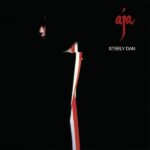 “Aja” – Steely Dan
“Aja” – Steely Dan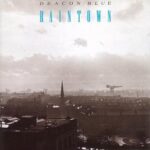 “Raintown” – Deacon Blue
“Raintown” – Deacon Blue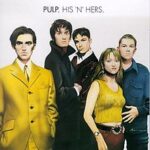 “His ‘n’ Hers” – Pulp
“His ‘n’ Hers” – Pulp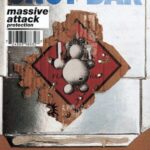 “Protection” – Massive Attack
“Protection” – Massive Attack
